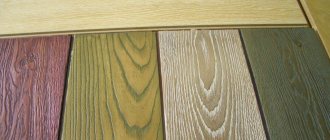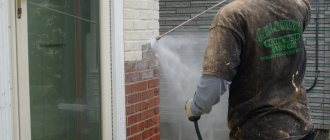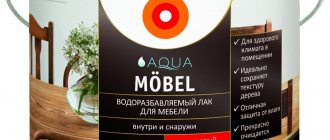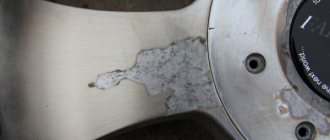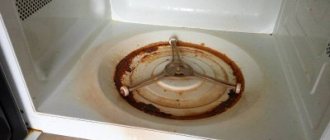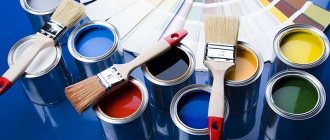The question “how to paint?” often turns into “what to paint with?” Because the result directly depends on the quality of the paints and varnishes that are used, but “how” also matters. This is where we will start.
By painting a log house we mean not only the finishing, but also all kinds of impregnations, primers, fire protection, etc.
How to paint a log house?
This can be done with a brush, paint roller, or spray gun. Painting with a spray gun: Some compounds cannot be painted with a spray gun due to their viscous consistency. For example, oil-wax. But there can always be exceptions.
In general, there are a lot of exceptions when it comes to painting log houses. They mainly concern the specifics of materials, of which there are now a great variety. Therefore, let us immediately note one more ironclad rule for high-quality and durable finishing of a log house with paints and varnishes - strictly follow the recommendations of the material manufacturer.
Before starting work, carefully read the technical information, which is not only on the can (bucket) of paint, but also in the manual accompanying the product - the “technical manual”. Such a detailed manual - in printed form - is a must-have for a serious dealer or supplier. If after getting acquainted with the “technical equipment” there are still some uncertainties, do not hesitate to call the manufacturer or official dealer and chat. Reputable firms are open to communication, and their consultants answer all questions in detail.
The safest way to paint a log house is with a brush. In this case, the composition penetrates better - deeper and more uniformly - into the surface of the wall, all defective areas are treated. Therefore, it is recommended to apply at least the first layer, or primer, with a brush. You can go over the brush immediately after the spray gun, especially if you are working together, to make sure that all areas are painted evenly. You should paint starting from the top crown down along the fibers of the log or timber.
Applying the first layer: first by spraying, then with a wide brush with short bristles, then with a finer one - in difficult areas.
Not all paintwork materials require preliminary priming, but the most important requirement when working with any composition is that the surface to be painted must be well sanded, clean and dust-free. Only then can you count on lasting results. Dust is removed with a dry rag, brush, industrial vacuum cleaner, or blown off with a hairdryer. Industrial hair dryers are also used to heat wax compositions directly on the wall during the application process - the heated composition is absorbed better and dries faster.
After applying the first coat of paint, the pile on the logs may rise. In this case, it is advisable to go over the walls with fine sandpaper, at least in some areas.
Keep in mind that the color of painted walls will approach that stated in the catalog only after applying the final (usually second) coat of paint, but will still be different. This is due to the fact that the perception of color on a small area of paper (screen) differs from the perception of the same color on a large-scale wall, and even in different lighting.
A little trick: In places where there are knots, the log or timber can be treated with varnish before painting (after cleaning off any exposed resin). This prevents paint degradation in such areas in the future. Not forever, perhaps, but the process will slow down.
You should not chase the number of coating layers. Usually two layers of normal paint or other protective composition are enough if everything is done correctly. Maximum of three. If the wood is of high quality, evenly dried and sanded, then when using some materials, even one layer may be enough! In this matter, you should also listen to the manufacturer’s advice.
It is ideal if the log house has already gone through a drying period before painting. That is, it is best to paint a dry log, the humidity of which is 5-12%, but not lower than 18%. The variation in different parts of the wall can reach 3-18%, and this is normal, since wood, especially chopped logs, dries unevenly. The fungus affects wood at a humidity above 18-19%, and if the log house is already dry and you see that everything is in order with the walls, then you can be sure that you will not catastrophically ruin them with any paint, and the coating will not peel off in a year.
Humidity can be checked with a moisture meter. The device is configured for a specific type of wood - pine, spruce, etc.
The paint consumption on the ends of logs is usually greater, since they absorb moisture better. In general, the point of painting the ends is to “seal” them. Moreover, this should be done BEFORE the frame shrinks! Why? Through the ends of the logs, gas and vapor exchange occurs several times more intense than through the surface along the fibers. Thus, the log dries unevenly; if the ends are open, this leads to more noticeable deformations of the crowns. In addition, it is the ends that are vulnerable to damage by fungus, rot, and insects. Subsequently, poorly painted ends become cold bridges due to intense gas and vapor exchange.
Drying rounded logs: the ends are already protected.
What does it mean to “seal” the ends of a frame? It is reasonable but generous to coat with a vapor-proof (or low-permeability) compound. As such, you can choose oil or alkyd paints, varnishes, drying oils, lime paint, mastics.
The ends of the frame are sealed with mastic.
Is it possible to paint a wet log house? Yes. It’s possible, but then you should definitely choose vapor-permeable compositions (we’ll talk about the variety and properties of paints and varnishes in more detail below). As a rule, these are acrylic water-soluble paints. It is recommended to treat the log house with bioprotection during drying; in these cases, transport bioprotection is used. Recommendations for painting a wooden facade from the seminar “Facade and Interior Paints”:
What is it like to paint a house? They are rarely painted even during major repairs!
First, with the question of repainting the conventional Khrushchev building, we turned to the utility workers, who, in fact, renovate the houses. They were surprised at the question. Like, during major renovations, we usually don’t paint the façade. Only if it needs to be insulated, then the “fur coat” must be painted. But the current practice of overhauls shows that during the overhaul process only houses where more than 50% of the walls in the apartments are frozen are insulated. There are only a few such houses; decisions on them are made by a commission in the Minsk City Executive Committee. And those who will be renovating receive documents where the color is already written down - the one approved by the Architecture and Construction Committee of the Minsk City Executive Committee. In theory, to change the color, residents need not only unanimous consent, but also approval by the committee. But they couldn’t remember any cases where someone wanted something “dark blue” or simply “not pink.”
Brushes and rollers for painting log houses
Everything is simple here. Brushes and rollers are:
- made of synthetic materials - nylon, polyester, etc.;
- from natural ones - bristles (pork), and wool - for rollers;
- combined - equal parts of both.
Synthetics – for water-soluble coatings. If the packaging of your paint says “solvent: white spirit” (or another organic solvent - less common), then take a brush exclusively with natural bristles, because organics dissolve synthetics. For the same reason, you can use combination brushes for water-soluble paints, but not for paintwork materials with white spirit. Why can’t you paint with natural brushes and water-soluble paint? In fact, it is possible, but it is inconvenient - natural bristles absorb water, this causes the working part of the brush to swell, and the paint, at least a little, loses its solvent base.
A good brush will hold the bristles tightly. You can ventilate the quality by tugging on the pile - the hairs should not fall out.
To apply some wax-based compounds, brushes with short, hard bristles and felt rags are used.
When working, you may need goggles or a mask and a respirator for protection. Especially if you paint with compositions containing organic solvents, turpentine, or work with Oxol drying oil, or alkyd paints. Some of them are quite toxic during the painting process.
Video on how to choose paint brushes:
How to paint a log house?
Typically, what they want and expect from coating a log house with paints and varnishes is:
- effective protection against fungi, mold, blue stains, insects, UV radiation, and other aggressive environmental influences (rain, frost);
- aesthetic appearance (as an option - so that the coating remains visible and emphasizes the natural texture of the wood, is glossy, etc.);
- With effective resistance to environmental influences, expectations are associated with the longevity of the results - that is, so that both protection and beauty last for a long time (15 years, or even 50 - before major repairs!);
- environmental friendliness of the result and even active health benefits (at this point the factor of “breathing” walls is popular);
- so that all this, if possible, can be done easily and cheaply.
But, unfortunately, everything is impossible at once. All that remains is to determine priorities and choose the optimal combination.
First, let's talk about labor intensity. If you are willing to spend not-so-minuscule funds, cover it with ten layers - that is, paint a lot and for a long time - separately applying bio-, fire-, UV protection, then primers, then the first-second-...-twelfth finishing layer, you won’t have to. There are compositions that, according to manufacturers, combine all this in a primer and topcoat (and the protection functions are duplicated). But, of course, you can choose additional fire-bioprotection from the manufacturer’s line, for example. By the way, the fire-bioprotective composition of most manufacturers is also a primer.
The video from Tikkurila is completely universal, it protects everything from almost everything:
Note: fire-bioprotection (also: fire-protection, otherwise fire retardants, and bio-protection is often combined) is applied before decorative painting!
Another tip: I remembered when I wrote about the “manufacturer’s line.” Company consultants and independent specialists unanimously recommend using formulations from one manufacturer and combining them according to its recommendations! As a last resort, if you have already applied a fire-bioprotective composition of one brand, but want another paint, then ask the manufacturers (first and second) about the possibility of paintwork compatibility.
Now about prices: good paint doesn’t come cheap! Especially when we are talking about advertised brands, like Tikkurila, Pinotex, or Remmers, for example. There are relatively inexpensive wax-based protective and decorative compositions, including from domestic manufacturers, which are positioned as environmentally friendly (and even healthy!), incredibly durable, according to the manufacturer, and if this is true, then great, but Word about them hasn't spread yet.
Besides! If you choose imported paint, expecting to receive higher quality than from domestic brands, then look for the opportunity to purchase a product produced and packaged in the final container in the country of the brand, and not somewhere in Russia under license. That is, if you want Tikkurila, then it’s safer to find a Finnish can! Because there are enough complaints and opinions that even if the paint is delivered “from there”, but is poured into cans here, then it is already “very spoiled”.
A little more about choosing paint from foreign manufacturers. I recommend paying attention to how the climate of the brand’s country corresponds to Russia’s. Each manufacturer primarily focuses on the consumer within its own country. For example, in southern Italy, Spain, and France, the climate is unlike ours, soft, and their façade paints are not exposed to such severe frosts as in Russia. Therefore, their products can show excellent performance there, but not here. Thus, between the Slovenian “Belinka” and the Finnish “Tikkurila” it is more advisable to choose the latter - the Finns at least know what frosts are.
Fragment from “Build not rebuild”:
Color selection algorithm
So how to choose the color of the facade? “At the initial stage of choosing the exterior of a house, it is very convenient to use special programs or online services that allow you to choose the color of the walls, windows, doors, roof, base of the house and decide whether you like the color combination or not. At the next stage, we recommend visiting a house exhibition, where you can see the selected color and texture of the material live on samples exhibited by manufacturers.
To make a final decision, it is advisable to paint a piece of wall approximately 0.5 x 1 meter in size and observe the sample during the day under different lighting conditions, and also, preferably, under different weather conditions - sunny and cloudy. In this case, the selection error will be minimized as much as possible.
As for practicality, light colors fade the least. White fades the slowest. However, it should be remembered that white color may become yellow over time. Thus, the most practical in this case may be a gray, dim color. It does not turn yellow over time and dust is practically invisible on it.
Dark colors look very impressive on facades, especially those with simple architectural forms. However, remember that they fade quickly. The leader in fading is black
If there is a need to use dark colors on the facade of the house, then you should pay attention to the warranty card for the paint, which indicates restrictions on the period of fading. Usually this is 5-7 years for dark colors,” shared Roman Konyakhin, manager of the “Low-Rise Country” exhibition of houses.
How to paint a plastered facade
When choosing paints for brick and concrete plastered facades, the same principles for choosing colors apply. But besides this, we should remember that our walls need paint not only for beauty. Yes, of course, the facade, and the whole street, where the walls of the houses are painted in bright colors, are pleasing to the eye, but it’s not just about the color. Paint must protect the surface of the facade from destruction: the sun, frost, strong winds and unclean air can damage even the most durable materials.
About the durability of the paint layer
Most experts and simply experienced craftsmen agree that almost any wooden house will need to be repainted after 8-10 years - and this is in the best case - if you want the facade to look beautiful and the paint to retain its protective properties. It often happens that you have to repaint it after 5-6 years, and this is normal. During this time, at least the antiseptic properties of the facade coating are lost, even if the appearance is still okay. If you choose glaze (colorless) paint (also known as “glaze”, “glaze”), then it is simply not designed to last more than 5-6 years.
Relatively durable are varnishes, alkyd paints and enamels that form a dense film on the wall surface. But the disadvantage of such paints and varnishes is that they clog the wall, blocking the natural property of the log house to “breathe”. Thus, one of the significant advantages of a wooden house made of logs or timber (of course, not glued) is lost. There can be no talk about environmental friendliness here.
A pigmented paint coating, that is, paint in the literal and precise sense of the word, better protects the frame from the effects of UV radiation, it is more durable, but it hides the texture of the wood. Here you need to choose - either “beautifulness” or the effectiveness of protection.
Difference between varnishes, enamels and paints:
How to properly paint the outside of a wooden house?
Before you start painting the facade, the surface must be properly prepared. The scope of work depends on the condition of the boards. A preliminary inspection should answer whether it is enough to just sand the surface or whether any damage or defects should be corrected. Regardless of the condition of the facade, you should start by cleaning the boards with a brush and water and detergent. To remove dirt, use a spatula or machine. Only after this the facade should be treated with sandpaper or a grinding machine. It is then recommended to fill small depressions and remove loose wood particles. Damaged elements must be replaced with new ones. Before painting, surfaces must be dusted and dried.
Painting
After mixing, the product should be applied directly from the can using a brush or roller. For painting, you can also use a special spray gun if the application with such a tool is recommended by the manufacturer. Carefully go over the entire surface, including the boards and walls of the house, once along the grain of the wood. It is recommended to apply 2-3 layers of the product, observing the intervals intended for drying. A facade in good technical condition, which has been recently updated, only needs to be covered with 1-2 layers of decorative layer after sanding the surface. It is worth adding that wood paint must have the appropriate moisture content. In addition, painting work must be carried out in appropriate conditions, i.e. when the air temperature is not lower than 5°C and with a humidity that does not exceed 80%.
This way, the renewed and protected wooden façade will serve for many years. When you notice abrasion, fading, cracking or peeling of the coating, the outer walls of the wooden house should be repainted.
Water or white spirit, acrylic or alkyd?
Water-soluble acrylic paints are considered optimal for painting a log house outside and inside. At the same time, it is worth paying attention so that the natural vapor permeability of the walls is not disturbed by any fire-retardant composition on an alkyd basis and with an organic solvent (in most cases, this is white spirit). That is, antiseptics, primers, etc. – must also maintain the vapor-permeable properties of the wall.
The following factors may be indicators that the paint is vapor-permeable and environmentally friendly:
- Coatings based on acrylic, acrylate, wax, or natural oils (usually linseed oil);
- absence of organic solvents, white spirit; instead of them - water;
- not alkyd, not oil, not based on drying oil;
- does not form a film on the surface being coated.
Briefly about the advantages of acrylic paints:
At the same time, there are alkyd water-soluble compounds, but their manufacturers avoid the issue of vapor permeability of walls after treatment with them. Therefore, it is better to avoid such compounds, or ask.
Remember when I said that in matters of painting there are many exceptions that relate to the properties of various paints and varnishes? Rather, these are not exceptions, but nuances that are lost from sight, because we operate with general concepts that characterize an entire class of materials - “oil-based,” “alkyd,” “water-soluble” (they are also sometimes “latex”), etc. .P. Here are a few of these exceptions, or “lost” nuances:
- “Alkyd” paints and varnishes usually mean compositions in which synthetic resins are the binder base. Such paints and varnishes are not good for a log house, yes. And they are usually diluted with organic solvents. But here is an example of the water-soluble alkyd tinted glaze “Valtti Aquacolor”. Its binder base is an alkyd resin made from vegetable oil. On the Russian website) nothing is said about the vapor permeability of the wall after painting with this azure. When asked directly whether it is vapor permeable, the answer came: “Yes it is, it is a filmless finishing composition under which the tree can “breathe”.”
- Oil paints, as a rule, form a vapor-proof film, which also cracks and peels due to our climate. Drying oils emit a strong odor, do not dry well, and can be toxic. But! There is natural drying oil (linseed oil), which is added to vapor-permeable compositions, for example, “Ruslagen mahogany”. And in general, it is part of “folk” and alternative protective and decorative coatings.
Which paints are vapor permeable:
Conclusion: To make sure you don’t make a mistake when choosing a paint or antiseptic, check with the manufacturer for the composition and properties of the paints and varnishes that interest you.
Nuances when painting
Since not all materials adhere well to each other, you must remember what kind of paint was used previously (oil, alkyd, acrylic). If painting work is performed by specialists, this issue should be clarified with them. When painting with acrylic dyes for the first time, in the future you will have to purchase only the same paintwork materials or those compatible with them.
Compatibility table for paints and varnishes. If the cell is colored blue, then the paint materials are compatible. There are the fewest restrictions on the use of acrylate water-dispersion coatings. The table shows that alkyd-acrylic paint cannot be applied over oil paint, but alkyd-styrene paint can be applied
An old house will require careful repair of cracks. Even after this, it is better to paint with a brush, since the roller will miss irregularities, microcracks and other problem areas. If old wood shows signs of pest damage, it is additionally treated with insecticides and antiseptics.
Particular attention is paid to the ends, as the elements most vulnerable to moisture. They are painted in 4–5 layers
Basic requirements for painting a wooden house:
- performed immediately after construction, and then at intervals depending on the type of paint;
- Pre-treatment with antiseptics and primer is required;
- It is advisable to carry out grinding;
- the paint is applied in several layers.
Fire - and bioprotection of the log house
According to the technology, such compositions are usually applied to a new log house before finishing painting. Then - depending on the circumstances.
Fire and bio protection are often combined in one composition, but there are also options separately. How much are they really needed?
There is an opinion that fire protection (at least for the facade) is not needed, since the house often catches fire from the inside, and it is not the walls that burn first, but the interior items (furniture, etc.). In most cases, people in a fire die not from the fire, but from the smoke gases (they suffocate), that is, it makes no difference, roughly speaking, the house will burn down in an hour or two - if you didn’t run away (put it out) right away, then there will be no one to run away , but there’s nothing to put out (a half-burnt wall is no better than a wall that’s burned to the ground).
Biosecurity is divided into:
- disinfectant (bleaching) compounds - long-acting antiseptics, and they are:
- short-term (transport) - within a year or two they are washed out, decompose, suitable for temporary protection of a log house (or logs) for the period of drying and transportation;
- long-term.
Manufacturers sometimes determine the validity period of long-term bioprotection to be 10 years or more. But it is worth considering that the functions of the bioprotective composition may include such things as protection from UV radiation, darkening of the log house, which are not directly related to protection from biological damage (insects, fungi, mold). And the composition may protect the wall from darkening for 10 years or more, but this does not mean that all protection functions are preserved equally throughout the entire period of validity. Again, different biohazards cause unequal destruction, and the processes occur with different intensities.
The house mushroom is enemy No. 1 of a wooden house; it can “devour” a bathhouse in a couple of months. Previously, log houses infected with it were burned, but now the fungus is destroyed with special means.
It is much easier to deal with such blue stains - treat with bleach and dry the wood normally.
The log house must be regularly inspected for pockets of biological damage and timely measures must be taken to update the protection, if necessary. And it is better to protect the log house from specific dangers, and not from everything at once. For example, if you paint a log house with a pigmented composition, then you do not need UV protection in an antiseptic - opaque paint will already protect the log house from the sun. In a dry log house, and even painted, fungus and mold will not grow - it needs a humidity above 18-20%. That is, damage is possible only in places of high humidity. They can be additionally protected from moisture, or treated with a protective antiseptic composition. In particular, only the lower crowns of the log house can be treated against fungus.
A layer of paint protects the antiseptic from being washed out by rain, therefore, if washout is the main problem with the durability of the antiseptic, then it will last as long as the paint retains its moisture-proof functions. In general, a creative approach is needed in this matter, but you should not forget about the manufacturer’s recommendations.
Below is a video comparing fire retardants:
Another video on how to make cheap and cheerful fire protection yourself. The protective function of this composition strongly depends on the speed at which it is washed out by rain, but if the log house is painted, the effect will be quite long:
Preparation for painting - wood processing
Before applying a paint layer, the walls of the house must be prepared ; the process includes processing and subsequent protection of the wood.
Processing is carried out in several stages :
- cleaning from dust, dirt, old paint layers, oil stains;
- grinding surfaces using a grinding machine;
- cleaning with brushes or blowing a vacuum cleaner.
A primer is applied to the prepared surface, providing fire protection and bioprotection of the wood, and an adhesive primer is applied on top of it.
Important: The quality and durability of the paint layer depends on the correct preparation of the base. Layers of primer must be applied on top of the dried previous layer.
The most common wood defects
- rotting of the end of the log;
- discoloration due to fungal or mold damage;
- corroded by wood-boring beetles, termites;
- rotting in high humidity conditions;
- fading in the sun;
- charring by fire.
Protective impregnations
Before transportation, freshly cut wood at logging sites is treated with temporary protection compounds with a validity period of about six months.
If wood is not treated with a protective compound during construction, it will quickly become unusable.
To protect wood from premature aging and damage, the following drugs :
- Antiseptics are means of bioprotection and treatment against fungi, algae, bacteria and insects.
- Fire retardants to impart fire retardant properties.
- Complex action drugs.
To protect and color wood, they offer compositions that differ in composition, texture and purpose; they can also be natural or organic.
Natural paints are harmless to humans and the environment, but are not durable and require renewal after 1-2 years, while synthetic compositions guarantee protection of wood for 7-35 years.
We recommend: Correct installation of siding on a wooden house. Decorating the outside of the house with your own hands step by step


